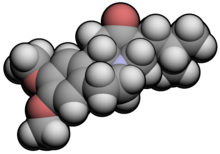Tetrabenazine
 | |
 | |
| Clinical data | |
|---|---|
| Trade names | Xenazine, Xentra, Nitoman, others |
| Other names | Ro-1-9569 |
| AHFS/Drugs.com | Consumer Drug Information |
| Pregnancy category |
|
By mouth | |
| ATC code | |
| Legal status | |
| Legal status | |
| Pharmacokinetic data | |
| Bioavailability | Low, extensive first pass effect |
| Protein binding | 82–85% |
| Metabolism | Liver (CYP2D6-mediated) |
| Elimination half-life | 10 hours parent compound (2 to 8 hours active metabolites)[3] |
| Excretion | Kidney (~75%) and fecal (7–16%)[4] |
| Identifiers | |
| |
JSmol) | |
| Chirality | Racemic mixture |
| |
| |
| (verify) | |
Tetrabenazine is a drug for the symptomatic treatment of
Medical uses
Tetrabenazine is used as a treatment, but not as a cure, for hyperkinetic disorders such as:[6][7]
- Huntington's disease – specifically, the chorea associated with it
- Tourette syndrome and other tic disorders
- Tardive dyskinesia,[8] a serious and sometimes irreversible side effect of long-term use of many antipsychotics, mainly typical antipsychotics
- Hemiballismus, spontaneous flinging limb movements due to contra-lateral subthalamic nucleus damage
Tetrabenazine has been used as an antipsychotic in the treatment of schizophrenia, both in the past[9][10][11][12][13][14][15][16] and in modern times.[17][18][19]
Side effects
The most common adverse reactions, which have occurred in at least 10% of subjects in studies and at least 5% greater than in subjects who received placebo, have been: sedation or somnolence, fatigue, insomnia, depression, suicidal thoughts, akathisia, anxiety and nausea.[4]
Warnings
There is a boxed warning associated with the use of tetrabenazine:[4]
- Increases the risk of depression and suicidal thoughts and behavior in patients with Huntington's disease
- Balance risks of depression and suicidality with the clinical need for control of chorea when considering the use of tetrabenazine
- Monitor patients for emergence or worsening of depression, suicidality or unusual changes in behavior
- Inform patients, caregivers and families of the risk of depression and suicidality and instruct to report behaviours of concern promptly to the treating physician
- Exercise caution when treating patients with a history of depression or prior suicide attempts or ideation
- Tetrabenazine is contraindicated in patients who are actively suicidal and in patients with untreated or inadequately treated depression
Pharmacology
The precise mechanism of action of tetrabenazine is unknown. Its anti-chorea effect is believed to be due to a reversible depletion of monoamines such as dopamine, serotonin, norepinephrine, and histamine from nerve terminals. Tetrabenazine reversibly inhibits vesicular monoamine transporter 2, resulting in decreased uptake of monoamines into synaptic vesicles, as well as depletion of monoamine storage.[4]
See also
References
- ^ "TETRABENAZINE RAN/TETRABENAZINE SUN/TETRABENAZINE RBX (Sun Pharma ANZ Pty Ltd)". Therapeutic Goods Administration.
- ^ Anvisa (2023-03-31). "RDC Nº 784 - Listas de Substâncias Entorpecentes, Psicotrópicas, Precursoras e Outras sob Controle Especial" [Collegiate Board Resolution No. 784 - Lists of Narcotic, Psychotropic, Precursor, and Other Substances under Special Control] (in Brazilian Portuguese). Diário Oficial da União (published 2023-04-04). Archived from the original on 2023-08-03. Retrieved 2023-08-16.
- PMID 19750050.
- ^ a b c d "Xenazine (tetrabenazine) Tablets, for Oral Use. Full Prescribing Information. Revised: 6/2015" (PDF). H. Lundbeck A/S. Retrieved 9 December 2015.
- ^ 1st US drug for Huntington's disease wins approval [dead link]
- S2CID 33577525.
- S2CID 22001960.
- S2CID 40131860.
- PMID 13832091.
- PMID 13745210.
- PMID 13748124.
- PMID 13684728.
- PMID 13874731.
- PMID 14453492.
- PMID 14081399.
- PMID 6007641.
- S2CID 39312847.
- S2CID 2649261.
- PMID 27721587.
External links
- Xenazine prescribing information FDA Archived 2017-02-16 at the Wayback Machine
- NIMH Repository data sheet
- "Tetrabenazine" from HOPES: Huntington's Disease Outreach Project for Education at Stanford
- Detailed monograph on tetrabenazine on rxmed.com
- Information on tetrabenazine from netdoctor.co.uk
